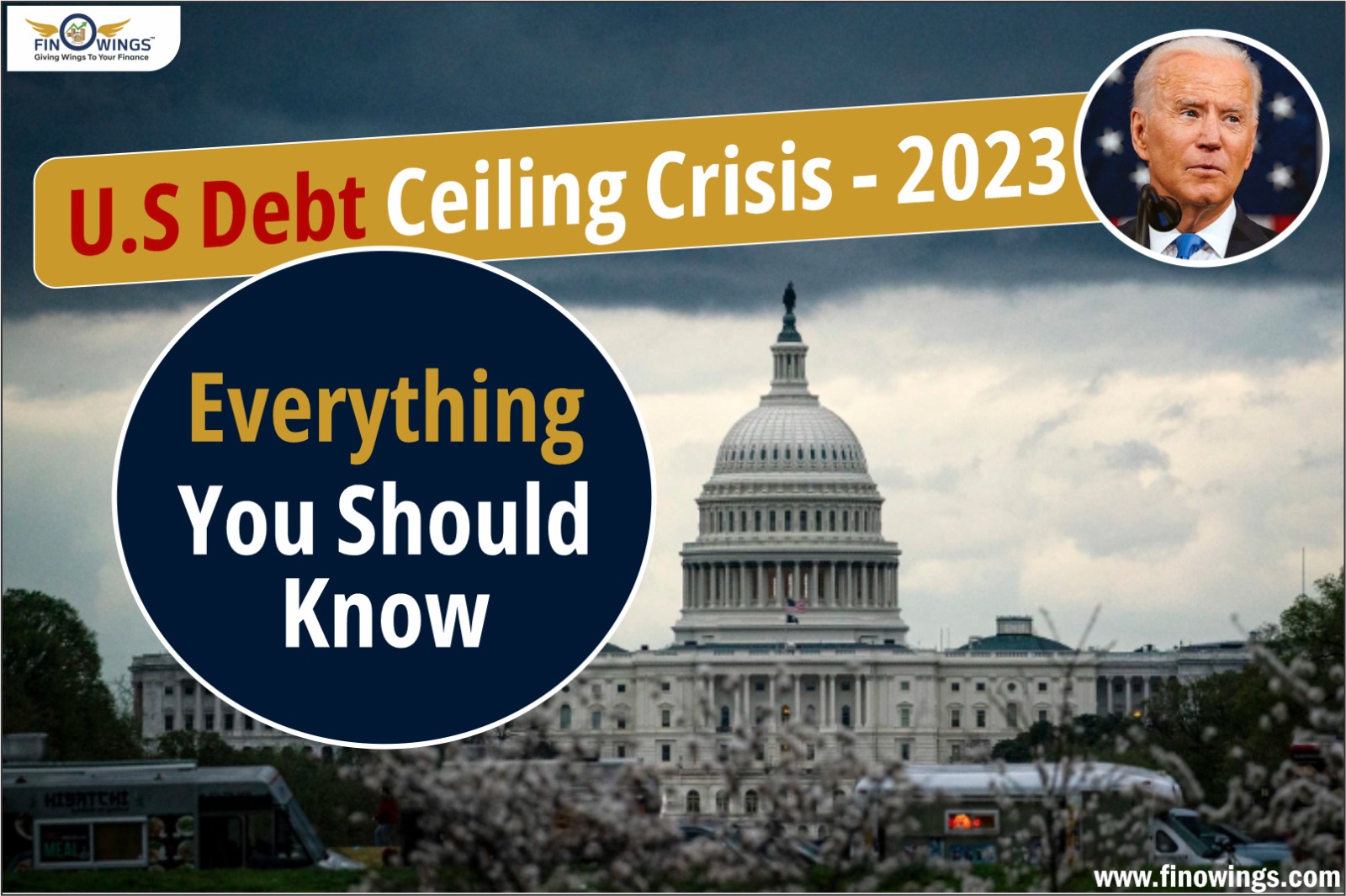Home >> Blog >> U.S Debt Ceiling Crisis - 2023 Everything you should know
U.S Debt Ceiling Crisis - 2023 Everything you should know

Table of Contents
- Introduction:
- What is the Debt Ceiling?
- How frequently is it brought up?
- If the United States violates the debt ceiling, what would happen?
- Other markets might be affected if the debt ceiling in the United States is breached.
- Does the public authority have any choices in the event that the roof isn't raised?
- Are policies similar in other nations?
- Is it appropriate to lift the debt ceiling?
- Conclusion:
Introduction:
The United States Treasury Department has had to borrow more money to pay for government spending as the national debt has increased. That might trigger the U.S. debt crisis. The official control on this getting is known as the obligation roof.
Congress must vote to suspend or raise the borrowing limit when the Treasury Department spends more than the ceiling allows. That means Congress also plays a crucial role in U.S. Debt Ceiling Crisis.
Financial experts caution of desperate results, including default, on the off chance that Congress can't agree on the roof.
Congress has authorized trillions of dollars in spending over the past ten years, nearly tripling the national debt since 2009. During that time, the Treasury Department's ability to borrow money to pay off its debt repeatedly ran into a limit on borrowing called the debt ceiling set by Congress.
Endeavors to raise or nullify the roof have turned into a subject of warmed banter among policymakers; In an effort to compel spending cuts, some lawmakers who criticize government debt have used negotiations to change the limit. Disruption, including government shutdowns and the specter of default, which has threatened to plunge the economy into crisis, has become increasingly common as a result of congressional brinkmanship over the issue. Economists are predicting catastrophic outcomes if the Treasury Department is unable to pay the nation's debts, which will put the issue back on the table in 2023 under President Joe Biden and a Republican-controlled House of Representatives.
And that's how U.S. Debt Ceiling Crisis begins.
What is the Debt Ceiling?
The debt limit, or ceiling, was established by Congress in 1917 to limit the amount of outstanding federal debt that the United States government can take on. The debt ceiling and total national debt stood at $31.4 trillion in January 2023. The U.S.U.S. government has run a shortage averaging almost $1 trillion consistently beginning around 2001, meaning it spends significantly more cash than it gets in charges and other income. In order to continue financing payments that Congress has already authorized, it must borrow money to make up the difference.
Because spending decisions are governed by separate laws, legislation to raise the debt ceiling does not increase the nation's financial commitments. Any change to the obligation roof requires greater part endorsement by the two offices of Congress.
How frequently is it brought up?
When the Government needs to borrow money to pay its debts, raising or suspending the debt ceiling becomes necessary. For a significant part of the previous 100 years, raising the roof has been a generally normal strategy for Congress. Congress has swiftly and sometimes unanimously increased the maximum amount it can borrow whenever the Treasury Department was unable to pay the Government's bills [PDF]. Congress has raised the ceiling seventy-eight times since 1960, the most recent time in 2021. Twenty-nine of these increases were implemented by Democratic presidents, while forty-nine of these increases were implemented by Republican presidents.
Instead of raising the debt ceiling by a specific amount, Congress has the option of either suspending it or allowing the Treasury to temporarily override it. While this move was interesting during the initial ninety years of the roof's presence, Congress has suspended it as far as possible multiple times beginning around 2013.
In 2011, when congressional Republicans and President Barack Obama fought over spending, a long-running impasse opened a new chapter in the debate over the debt ceiling. Congress, in the end, arrived at an arrangement to raise the roof only two days before the date that the Depository assessed it would reach a dead end financially. However, the brinkmanship led to the most volatile week for U.S.U.S. stocks since the 2008 financial crisis and the credit rating agency S&P Global downgraded the United States' creditworthiness for the very first time. The delay in reaching a deal, according to the Government Accountability Office, the federal auditor, increased borrowing costs in the United States by $1.3 billion [PDF] just that year. In May 2023, the evaluations office of Fitch put the U.S. obligation on bad watch, a stage that ordinarily goes before a minimization.
Votes to raise the debt ceiling have remained contentious as political polarization in the United States has grown over the past decade, with congressional budget hawks increasingly demanding spending cuts in exchange for their support. The debate over the debt ceiling forced the Government into a shutdown in 2013 when it was scheduled to expire, and in 2021, the issue once more came down to the wire. President Biden and senior Republicans in the House of Representatives are negotiating an increase in exchange for reductions in federal spending as policymakers discuss the debt ceiling once more in 2023.
You wouldn't just keep increasing the credit limit if you gave your child a credit card and they kept going over it. On Twitter, House Majority Leader Kevin McCarthy wrote, "You would sit down with them to identify where they are overspending and where they can change their behavior." The Federal Government should follow suit at this point.
The Republican proposals to impose work requirements on some recipients of federal benefits, establish permanent spending caps, and relax permitting requirements for fossil fuel energy projects will be the focus of the negotiations as of May 2023.
If the United States violates the debt ceiling, what would happen?
Economists like C.F.R.'s Roger Ferguson have begun to consider the once-unimaginable possibility of a U.S. default - that is, Washington declaring that it is unable to pay its debts - as a result of the debate over the debt ceiling. That would, according to some experts, signal economic chaos across the globe and the United States. Indeed, even shy of default, raising a ruckus around the town roof would hamstring the public authority's capacity to back its tasks, including accommodating the public guard or financing privileges like Government medical care or Government managed retirement.
A credit rating agency's downgrade, higher borrowing costs for businesses and homeowners, and a decline in consumer confidence are all possible outcomes of reaching the ceiling. These outcomes could shock the financial market in the United States and send the global economy into an immediate recession.
At a C.F.R. event in April 2023, former Treasury Secretary Jacob Lew stated, "I think it's pretty safe to say that if we were to default, it makes the odds of a recession almost certain."
Goldman Sachs financial specialists have assessed that a break of the obligation roof would promptly end around one-10th of U.S.U.S. financial action. Third Way, a center-left think tank, claims that a breach that results in default could result in the loss of three million jobs, an increase of $130,000 to the cost of an average thirty-year mortgage, and an increase in interest rates that would be sufficient to add $850 billion to the national debt. Additionally, if interest rates rise in the future, taxpayer funds may be diverted from vital federal investments in infrastructure, education, and health care.
"Failure to meet the government's obligations would cause irreparable harm to the U.S.U.S. economy, the livelihoods of all Americans, and global financial stability," wrote Treasury Secretary Janet Yellen in a January 2023 letter to Congress.
Other markets might be affected if the debt ceiling in the United States is breached.
According to experts, global financial markets could suffer greatly if the United States defaults. Demand for U.S.U.S. dollars has long been bolstered by the creditworthiness of treasury securities, contributing to their value and status as the world's reserve currency. Investors could sell U.S.U.S. treasury bonds and potentially weaken the dollar if confidence in the U.S.U.S. economy is impacted by default or the uncertainty surrounding it.
Since the United States of America holds more than half of the world's reserves of foreign currencies, a sudden drop in the value of the currency could have an impact on the market for treasuries. As vigorously obligated low-pay nations battle to make revenue installments on their sovereign obligations, a more fragile dollar could make obligations designated in different monetary forms generally more costly and take steps to tip a few arising economies into obligation or political emergencies.
Numerous U.S.U.S. exporters could profit from dollar devaluation since it would increment unfamiliar interest for their merchandise by really making them less expensive. However, rising interest rates would also result in higher borrowing costs for the same businesses. China and other potential rival great powers may also benefit from dollar instability. The renminbi is responsible for 3% of the world's allotted foreign reserves, despite Beijing's long-standing desire to position it as a global reserve.
Marcus Noland, executive vice president and director of studies at the Peterson Institute for International Economics, a nonpartisan think tank, writes, "The notion that it would commit its own goal and hand China such an opportunity seems incomprehensible for a Congress that is obsessed with America's standing vis-a-vis China."
Does the public authority have any choices in the event that the roof isn't raised?
On the off chance that legislative exchanges over the obligation roof are not settled before the roof is reached, the Depository can fight off a default for a long time with a progression of impermanent activities it calls "exceptional measures." These incorporate suspending installments to some administration representative reserve funds programs, underinvesting in specific government reserves, and deferring sell-offs of protections.
While the Depository had utilized these actions when past exchanges slowed down - remembering for 2011 and 2013 - Congress has never neglected to raise the roof before the actions have been drained. Federal spending would have to significantly decrease, or taxes would have to significantly rise (or a combination of the two) if Congress does not act to raise the debt limit despite these emergency measures. On January 19, 2023, the debt ceiling was reached without a deal; Yellen, the secretary of the Treasury, has expressed concern that extraordinary measures may be exhausted by June 1. According to experts, it could take more than a decade to cut federal spending and raise enough tax revenue to cover the necessary payments.
As that date approached without an arrangement to raise or suspend the cutoff, a few specialists proposed choices that wouldn't need legislative endorsement. These include calling on the United States Constitution's Fourteenth Amendment to issue more debt, which says that "the validity of the public debt of the United States... shall not be questioned." others incorporate selling U.S.U.S. gold and stamping a platinum coin worth $1 trillion. Biden has called these measures untenable in public. The Treasury Department could also hold off on paying Social Security and Medicare beneficiaries, as well as military salaries. It has the option of putting debt payments first, but Yellen called that a "default by another name" in March 2023.
Long impasses over the debt ceiling can be enough to shake investor confidence, despite the cushion of extraordinary measures. Interest rates on four-week U.S.U.S. Treasury bills, long regarded as the financial system's safest asset, reached a record high in May 2023
Are policies similar in other nations?
Only a few nations have debt ceilings that are regularly threatened with serious economic disruption, and Denmark has one, but it hasn't been a problem because it's so much higher than the country spends. Denmark's central government debt was approximately 14% of its ceiling in 2021 [PDF]. In the midst of large budget deficits, Australia implemented a debt limit in 2007 with the intention of legislating fiscal responsibility. The roof was raised a few times prior to being revoked in 2013. The spending limit in Poland's constitution is 60 percent of G.D.P., but borrowing is not restricted.
Is it appropriate to lift the debt ceiling?
The debt limit, according to some analysts, gives Congress some oversight authority and encourages fiscal accountability by requiring legislative consent. By allowing the Treasury to issue debt up to the ceiling without obtaining congressional approval for each issue, the original legislation from 1917 aimed to provide the Treasury with some degree of autonomy over borrowing; Before 1917, Congress gave the Treasury permission to borrow in smaller amounts. However, in recent years, opposition parties have frequently leveraged debt limit negotiations to influence policies that are not directly related to the ceiling.
According to some economists, the debt ceiling still serves a useful purpose by establishing a believable commitment to reduce spending. They bring up that past discussions over the obligation roof prompted concessions that reduced spending. In 2023, a lot of congressional Republicans have listened, and they've tied debt ceiling talks to their worries that growing budget deficits are hurting the economy of the United States.
However, numerous other economists and policymakers argue that the federal debt ceiling is antithetical to sound fiscal policy, stating that it is irrational to prevent the Government from meeting financial obligations that have already been enacted. In 2013, 97 percent of U.S.U.S. financial specialists assembled by the College of Chicago concurred that the U.S. component for raising the obligation roof could prompt terrible financial results. That group includes Yellen, who has argued that the debt ceiling is bad for the U.S. economy because it primarily restricts borrowing to pay for previous commitments.
Ferguson of C.F.R. agrees. Congress ought to dispose of the obligation roof totally, or possibly attach it to spending to such an extent that as far as possible increments consequently while a spending bill passes," he composes. It is necessary for the United States of America to get rid of this out-of-date system that frequently puts the country in danger of default.
Conclusion:
During World War I, the debt ceiling was established to control government spending and maintain fiscal responsibility. Despite concerns about the debt ceiling's effectiveness, the debt ceiling has been raised or revised 78 times since then to prevent default and maintain economic stability in the United States. Congress has not indicated that it will consider other options.
Author
Frequently Asked Questions
The U.S. debt ceiling is a legal limit set by Congress on the amount of money that the federal government can borrow to finance its operations and meet its financial obligations.
During a debt ceiling crisis, the government reaches its borrowing limit, and the Treasury Department exhausts its extraordinary measures to continue funding government operations. This leads to a potential government shutdown, delayed payments, and a risk of default on the country's financial obligations.
The debt ceiling is crucial because it determines the government's ability to borrow money to meet its financial obligations, including paying for programs, services, and interest on existing debt. Failure to raise the debt ceiling can result in severe consequences for the economy and financial markets.
The U.S. debt ceiling has significant implications for the economy. A failure to raise the debt ceiling could lead to a default on government debt, causing increased borrowing costs, market instability, reduced investor confidence, and potential economic downturns.
The authority to raise the U.S. debt ceiling lies with Congress. Specifically, both the House of Representatives and the Senate must pass legislation to increase or suspend the debt ceiling. The President may sign the legislation into law or veto it.
If the U.S. debt ceiling is not raised, the government may not have enough funds to meet its financial obligations, leading to a potential default on debt payments, delayed Social Security checks, disruptions in government services, and a negative impact on the economy both nationally and globally.

















